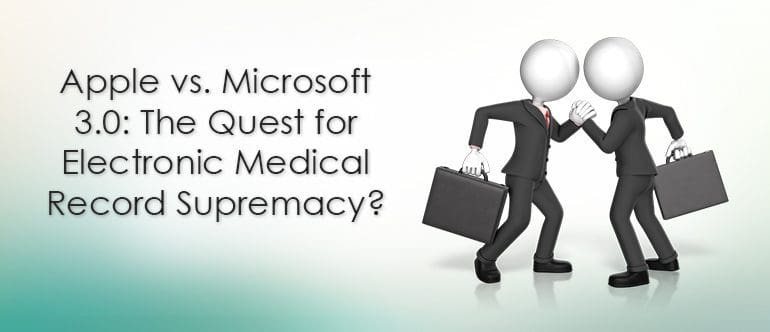Call us toll-free: 800-878-7828 — Monday - Friday — 8AM - 5PM EST


By Bob Skelley for Computerworld
The future of healthcare delivery may rest in balance
The current state of healthcare delivery, and specifically electronic medical records (EMR), is reminiscent of the state of office productivity software in the business world during the ’90s.
During the late ’80s and into the ’90s, WordPerfect, Microsoft Word and a host of lesser word processors battled for supremacy in the business world. Each had their pros and cons, but the global economy would really explode in the late ’90s once one of these titans became the industry standard.
Apple had conceded the desktop operating system wars to Microsoft well in advance of the battle for word processing champion. By the time the best OS Microsoft has ever produced (prior to Windows 10) — Windows XP — was released, Apple was well into its process of reinventing itself as a consumer oriented, and not an enterprise-focused, company.
We know what’s transpired since Microsoft out marketed both Apple (for desktop computer OS supremacy) and the makers of WordPerfect as the word processing gold standard.
Apple went on to claim smartphone dominance — and Microsoft similarly handled rival Novell and Corel versions of WordPerfect to become office productivity suite king.
Apple beat out the late-to-the-table Windows Phones and holds on to the top spot today over Android-based versions.
So, to date:
- Microsoft becomes king of the desktop computer operating system and achieves recognition as business world, word processing and office productivity suite software standard bearer.
- Apple becomes king of the smartphone before Microsoft even becomes a player.
Number 1 actually encompasses two things, but they happened around the same time and were interrelated by virtue of the fact that Word, Excel and PowerPoint run on both Windows and Macs — the unquestioned business world, office suite standard for both computing platforms.
Number 2 is just a statement of clear cut dominance by Apple in the smartphone vertical segment.
What the world is waiting for now is a good old-fashioned heavyweight rubber match between Apple and Microsoft; well, it might not be waiting for it, but in the name of healthcare, it should be hoping for it.
Some would say this is not likely as neither is a company that competes so much as complements one another at this time.
Microsoft recently closed on its acquisition of LinkedIn. (I’m still waiting to see how that one turns out. LinkedIn has received somewhat of a facelift and makeover. It also doesn’t let me post the same material twice anymore on the social network for professionals going places, but I digress.)
The 800 lb. gorilla in the room is EMR
Healthcare delivery is set to simultaneously explode and implode. Baby boomers will stress an already overtaxed system ill-equipped to keep up accurately with present, modern-day demands.
What nobody is talking about is how difficult it will be to make advances in healthcare delivery with the overwhelming number of EMR choices available to private practices, medical groups and hospitals. This is because variation, whether in EMRs or office productivity suite choices, is surely the enemy of quality.
There are literally dozens of EMR choices and they are all being utilized to some degree. There are no clear cut favorites, either, regarding which, if any EMR, will win out as a standard in the end.
And the end of multiple EMR choices cannot come soon enough. In fact, an Obamacare replacement will be hindered by the lack of an EMR standard.
We’ll only get so far with the status quo.
Enter Microsoft and Apple wearing Everlast boxing gloves, just like the good old days, or not.
Healthcare is a multi-billion dollar industry and all too plentiful EMR choices are thwarting efforts at cost containment, redundancy elimination and advancements for real progress in medical procedure, pharmaceutical and surgical development, not to mention actual delivery of high-quality patient healthcare.
One argument against Apple ever competing in this space is they no longer serve the enterprise except in ancillary or augmentative capacities. An argument against Microsoft throwing their hat in this ring is that creating an EMR standard — and all it entails — is just too complex and costly a venture to enter into at this late stage of the game.
The final piece of this heavyweight tilt may just be the unexpected. That is, the fight for EMR supremacy between Apple and Microsoft might never come to pass because they end up actually partnering to achieve a mutually beneficial solution in the EMR space.
How can this be?
Apple already promotes Apple Watch heavily as a fitness device. Accordingly, it feeds data into systems which mine, filter and regurgitate this info to consumers and healthcare practitioners in a variety of ways — all in the name of promoting healthy and active lifestyles.
Could Apple continue to play the consumer card it is known for and Microsoft be relied upon to do the heavy lifting on developing an EMR standard of its own?
I think there is room for the possibility of both. For Microsoft to succeed in its part, however, it’d have to incorporate advanced OCR, handwriting analysis and dictation capabilities into its product.
Finally, EMRs would have to network easily and effectively with hospital-based equivalents and the very data-feeding consumers that Apple would serve in this scenario.
It could happen. It should happen. I dare it to happen.
